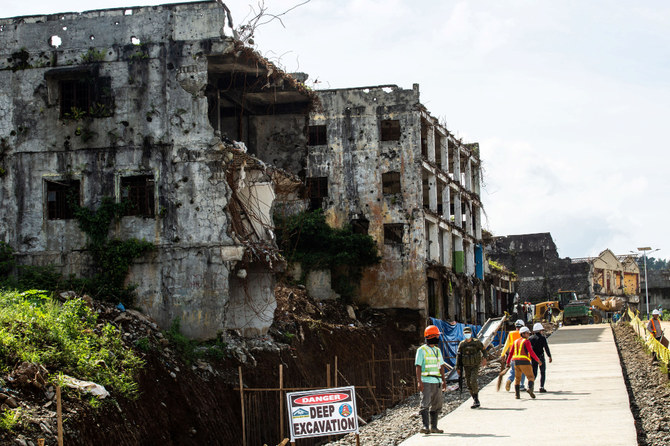MANILA: Four years after pro-Daesh militants captured Marawi, leading to months of fighting with the Philippine Army that reduced the city to ruins, the chief reconstruction official said on Monday the restoration process should be completed by the end of President Rodrigo Duterte’s term in June.
The siege of the lakeside town on the island of Mindanao began on May 23, 2017, and lasted five months, leaving more than 1,100 people dead. It was the military’s toughest and longest conflict since the Second World War.
Marawi suffered widespread damage during the fighting, which forced more than 100,000 residents from their homes in the predominantly Muslim city, according to International Committee of the Red Cross estimates.
“The Task Force Bangon Marawi, along with its 56 implementing agencies, remains on track in completing all infrastructure projects included in the master development plan within the term of President Rodrigo Duterte,” Maj. Gen. (Retd.) Eduardo Del Rosario, head of Task Force Bangon Marawi, an inter-agency task force in charge of reconstruction, told Arab News.
“Rehabilitation of public infrastructures in the city is now 75 to 80 percent complete,” he added.
As Marawi marked the fourth anniversary of its liberation from the Daesh-affiliate militant Maute group on Saturday, Duterte inaugurated the reconstructed Grand Mosque of Marawi.
“This place holds historical and cultural significance in the lives of the Maranaos, who will rejoice as a nation as the Grand Mosque of Marawi brings hope to our Muslim brothers and sisters,” the president said, as the mosque reopened for public use.
So far five of the city’s 30 mosques have been rebuilt, according to Del Rosario, who said the reopening of the Grand Mosque was a symbol of the Duterte administration’s “full commitment to rehabilitate Marawi.”
During the mosque’s reopening, Bangsamoro Autonomous Region in Muslim Mindanao MP Zia Alonto Adiong said the end of the 2017 conflict in Marawi had “left behind so much death and destruction,” but added its residents had been determined to “rise from the ashes of war” and rebuild their communities.
“I am hopeful that in our lifetime, we will see the rise of a better Marawi, a Marawi City with stronger and more resilient communities as its core foundation,” Adiong said.
But the majority of the displaced still cannot return to their homes. Most are living with relatives, while others remain stuck in evacuation centers.
Del Rosario was unable to say whether their houses would be restored by the end of Duterte’s term.
While the reconstruction task force was created in 2017, the city’s rehabilitation has been a process marred by delays.
“The people of Marawi all wish to go home,” Mindanao Party List Representative Amihilda Sangcopan said after the reopening of Grand Mosque, as she called for the restoration of houses to be fast-tracked. “Let us give them the chance to feel the normalcy of life back, a life they used to have four years prior.”

